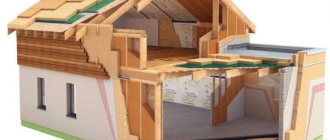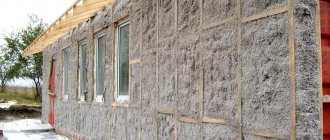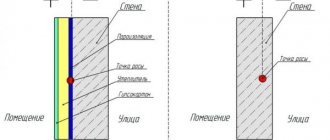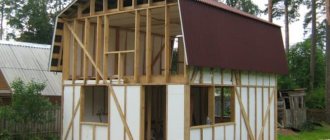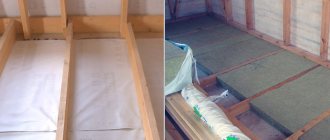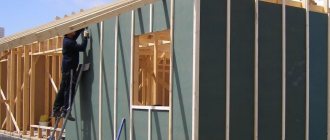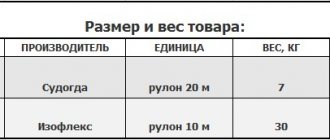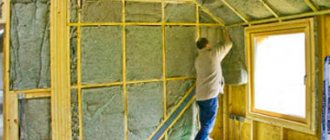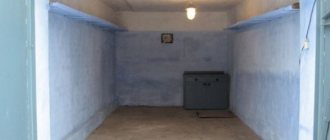What is basalt insulation, characteristics and applications
Basalt wool (BW) is a type of mineral wool.
Melted fibers of the volcanic rock of the same name, which have high strength and hardness, are used as raw materials for its production. In its structure and manufacturing technology, BV differs little from its mineral counterparts, however, its mechanical characteristics are noticeably higher, and its thermal conductivity is quite comparable to materials such as foam rubber, balsa wood and expanded polystyrene. Due to its long service life and ease of installation, basalt insulation has become the most widely used. The material can be used for thermal insulation of both internal and external surfaces. High vapor permeability ensures optimal microclimate parameters; in addition, basalt wool practically does not absorb moisture.
The best offer on the market
Today, the Russian market offers thermal insulating basalt slabs from various domestic and foreign manufacturers. Such insulation is distinguished by the quality of its workmanship; it is a reliable and durable material. Products from the following manufacturers have proven themselves to be the best:
- Rockwool. This is a world leader in the production of thermal insulators based on stone and basalt wool. A wide range of offers is combined with the excellent quality of such products. Buyers will be able to purchase high-quality and inexpensive Rockwool basalt slabs, which are manufactured in various sizes and may differ in their density, strength and other characteristics. The manufacturer offers a long-term quality guarantee for its products.
- Izovol. This is a leading domestic manufacturer of thermal insulation board materials. A wide selection of izovol products allows you to select an insulator for any operating conditions of the insulation. The heat insulator is offered to customers at affordable prices, is characterized by excellent strength, and thanks to its increased size and thickness, it greatly simplifies repair work on insulating private houses and various buildings.
- Basalt insulation from TechnoNIKOL is in excellent demand in the domestic market. This is a durable insulator, the production of which uses modern technologies, which guarantees the quality of the product. You can choose heavy-duty, dense types of basalt wool, which are intended for insulating pipelines, as well as relatively inexpensive insulation materials with a density of 50-75 kilograms per cubic meter, which allows them to be used for thermal insulation of private buildings.

The quality of purchased insulation based on basalt slabs must be given due attention. The durability of the material, as well as the effectiveness of the insulation performed, will directly depend on the quality of the insulator
Therefore, you should not save on the purchase of basalt insulation. It is recommended to give preference to products from leading manufacturers who have proven themselves to be the best in the domestic market, which will allow you to be completely confident in the correctness of the choice made and the durability of the repairs carried out.
Basalt slab insulation is a completely natural, environmentally friendly and inexpensive heat insulator, which is characterized by improved sound and heat insulation of the room. It is only necessary to choose the right slabs of such an insulator, which may differ in their density, strength and a number of other characteristics. Basalt slabs are very popular for internal and external insulation of private houses made of various materials. Such insulators are easy to use, which allows you to do all repair work yourself.
Basalt insulation. Mineral wool. Types, properties:
Types of basalt insulation
Depending on the purpose, various modifications of basalt wool are produced:
- Soft wool
is not designed for significant mechanical loads, but due to its porous structure, it is one of the most effective heat insulators. - Medium strength slabs
are designed for insulation of ventilated facades, sound insulation and protection of air ducts from open fire in case of fire. The thermal insulation properties of the material are no worse than those of soft wool, but the cost is significantly higher. - Rigid basalt slabs
are able to withstand significant mechanical loads without losing their thermal insulation properties. They are used for insulating floors, for exterior work and for insulating frame partitions. - Foil-coated basalt wool
not only contributes to thermal insulation, but also reflects some of the heat back into the room. Basalt insulation can be covered with a layer of foil on either one or both sides. When using BV with one-sided foil, the material is placed with a reflector inside the room.
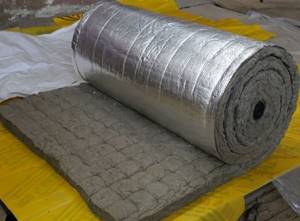
Both rolled and sheet basalt wool has minimal thermal conductivity and ensures sufficient air circulation.
Laying basalt slabs
Insulation of the enclosing structures of a frame house with basalt wool is most effective if the installation rules are followed:
- Unloaded surfaces - floors, joist floors, roof slopes - are insulated with loose roll insulation or soft low-density slabs - up to 35 kg/m³;
- PM 40, PM 50 are installed in the internal partitions;
- To protect facades, denser slabs PP 80 - PZH 140 are used, for plaster finishing - PZH 160 and higher;
- To eliminate cold bridges, it is better to replace thick materials with 2 thinner layers, for example, a 200 mm slab with two 100 mm each;
- The layout is carried out with a seam spacing of at least 150 mm;
- The products are mounted in the spacer between the frame posts or floor joists without gaps; for this purpose, an allowance of 10-20 mm is left when cutting;
- Be sure to lay a moisture- and windproof membrane on the outside of the insulation, a film vapor barrier on the room side, and carefully glue the seams;
- Places where rodents have direct access are covered with metal mesh; mice do not eat basalt, but make passages in it and use fiber to make nests;
- If there is a layer of aluminum, the insulation is laid with the foil side facing the room;
- Cut the material with a sharp knife or saw with fine teeth;
- When cutting, installing or moving, mineral wool protects the respiratory system and skin from contact with microparticles of insulation. Use a mask or respirator, gloves with rubber coating on the palms, and clothing made of thick fabrics.
Advantages and disadvantages of basalt insulation
Using basalt wool as thermal insulation has a number of advantages:
Thermal conductivity
material is extremely small and can range from 0.032 – 0.048 W/m 0 K. For comparison: 10 cm thick basalt insulation will replace:
- 25.5 cm natural wood;
- 117 cm ceramic bricks;
- 160 cm clay brick;
- 200 cm of silicate masonry.
At the same time, the specific gravity of BW will not exceed 100 kg/m3.
Moisture resistance of the material
. Basalt insulation absorbs no more than 2% water per unit volume. The hydrophobicity of the material allows it to be used for thermal insulation of objects with high humidity: building foundations, baths, saunas, etc.
Vapor permeability
at the level of 0.3 mg/ (m h Pa) provides a comfortable microclimate. Thanks to the porous structure, moist air is able to freely pass through the insulation layer without affecting the thermal insulation properties of the material.
Fire safety
basalt wool according to GOST 30224 belongs to the NG group (non-combustible materials). In addition, BV can prevent the spread of open fire and has a resistance limit before melting of 1114 0 C.
Soundproofing characteristics
basalt insulation allows you to provide an acceptable degree of comfort.
Mechanical strength
during compression, depending on the modification, it can fluctuate between 5 and 80 kPa. Thanks to the specific arrangement of the fibers, even not the most durable brands of stone wool are able to withstand significant loads without collapsing.
Resistance to chemical and biological influences
makes it possible to widely use stone wool for thermal insulation of special objects. Insulation made from basalt fibers does not interact with chemically active compounds, is resistant to rodent attacks and does not contribute to the development of mold.
Environmental Safety
The material is due to the use of natural raw materials. Binding components containing formaldehyde resins do not emit phenol, since they are neutralized during the production process.
Long service life
is a consequence of the optimal combination of the above properties.
As for the disadvantages, it can hardly be attributed to them the need to work with gloves and a respirator, since this is not a weak link, but basic safety rules that have not yet been canceled, and they apply not only to basalt insulation. Complaints about the presence of seams are more reminiscent of baby talk than justified claims, since a monolithic heat insulator has not yet been invented, any insulation has to be joined.
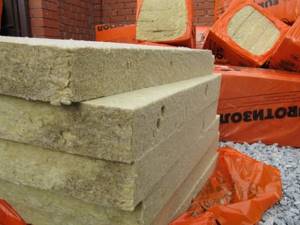
The relatively high cost is fully justified by the performance properties and service life, and the material is simply not intended for thermal insulation of plinths and basements.
How to find out the recommended thickness of the basalt layer
There is a formula by which you can find out the optimal thickness indicators. Then the thermal insulation will fully perform its functions and the funds will not be wasted. To begin with, you should find out the following indicators:
- R – thermal resistance. It is designated m2*K/W;
- λB – thermal conductivity of basalt wool (indicated on the packaging from the manufacturer). Let's choose average values of 0.45 (W/m2 * K).
Index B indicates the possibility of using insulation for rooms with high humidity. R – thermal resistance (the properties of a material to prevent heat from passing through it. The higher this indicator, the better the heat is retained inside.
On average, for walls this coefficient is 3.3 m2*K/W, for a roof – 4.95 m2*K/W. Based on the formula (R* λB), you can calculate the thickness of the wool layer for wall insulation: 3.3 * 0.45 = 1.485 m = 14.85 cm. If we round, we get the optimal thickness of the basalt layer of 15 cm.
For the roof, the indicators are as follows: 4.95 * 0.45 = 2.2275 m. By rounding, you can get a thickness of 22.3 cm. Now that the thickness has been decided, you can insulate the facade with basalt slabs, the roof or walls from the inside.
Features of the production of basalt insulation
For basalt insulation, the general specific name “mineral wool” is often used, under which glass wool and slag wool are also produced.
Basalt, or stone, wool is made from molten gabbro-basalt rock, quartz is used to produce glass wool, and slag materials are made from waste from mining and metallurgical enterprises - blast furnace slag.
The basis of stone wool is thin basalt fibers, which can be arranged horizontally in the form of layers, vertically, structurally corrugated or randomly.
To obtain such thin fibers, basalt rock is melted at a temperature of more than 1500 °C and drawn on special drums to obtain thin threads no more than 7 microns thick and up to 50 mm long.
Based on the thickness of the fiber, basalt insulation materials receive a special marking: BTV - materials made from a thin thread, and BSTV - from an ultra-fine one.
To obtain a thermal insulation material, the fibers are glued together using arbolo-urea resins, which are safe for health and do not contain formaldehyde, after which the products are formed, which are produced industrially in the form of slabs, mats or cylinders.
It is important to take into account that types of products with equal thickness may have different densities, which determines such material parameters as weight, caking resistance and thermal conductivity.
Therefore, when choosing insulation, you should take this characteristic into account and use materials recommended for thermal insulation of specific structural elements.
Characteristics of basalt insulation
The main characteristic that is taken into account when choosing thermal insulation, naturally, is the thermal conductivity coefficient: the lower it is, the better the material will cope with its task.
And first of all, you should pay attention to the environmental friendliness of the product, its ability or inability to emit dangerous compounds or dust particles, inhaling which a person gradually harms his health.
According to this criterion, basalt wool takes a leading position, since it is a natural material, and the proportion of synthetic resins is too small and, in addition, their composition is absolutely safe.
But when choosing a material, you should give preference to proven brands whose manufacturers do not risk their reputation and do not use cheaper analogues of adhesive resins.
Products with a little-known history do not always meet this criterion, so you should carefully study the product labeling, as well as the accompanying information.
When using basalt insulation indoors, it is especially important to sheath the wall or ceiling to completely prevent small particles of the material from entering the air.
Despite the fact that dust from insulation does not pose an allergenic or toxic hazard, mechanical irritation of the upper respiratory tract cannot be ruled out.
Thermal conductivity
Basalt insulation is considered a material with very low thermal conductivity, the coefficient of which may differ for different products, depending on their thickness and type, and is in the range of 0.30-0.48 W/(m∙K).
Excellent thermal insulation characteristics are provided by the fibrous structure of the material - small air chambers are formed between the layers, which serve as a heat insulator.
It should be taken into account that the density of basalt insulation can be different: the higher it is, the more thick a material is required to achieve the desired effect, and vice versa.
It would seem that everything in this case is clear - you should buy looser and thinner insulation, but this rule does not always work, since various types of work require products that have certain performance characteristics, the main of which are strength and resistance to caking in during operation.
If we compare different materials in terms of their ability to retain heat, then only 10 cm of thickness of basalt insulation with an average density is comparable in this parameter to 1.5 m of brickwork and 2 m of cellular concrete walls, as well as 30 cm of a wooden frame.
Basalt insulation. Video:
Is basalt wool harmful to health?
Particular interest in the degree of harmlessness of basalt wool is caused primarily by the fact that the material is actively used as insulation. People come into contact with it, so it is important to know whether the composition poses a threat. If you look at the question objectively, the material does not pose any threat, it is environmentally friendly.
Previously, glass wool was widely used as an insulating composition, which could really cause irreparable harm to health. Basalt insulation cannot be compared with it. The harm to health depends entirely on how well the insulating layer is made. If it is not there, then the material may cause certain problems.
The main problem with basalt-based products is that they can crumble during installation. If the worker is not wearing protective elements (gloves, respirator, goggles), tiny particles may enter the lungs and result in an allergic reaction. Once on the body, the particles can cause itching.
Important! If it gets into the eyes, there is a risk of damage to the mucous membrane.
Above we are talking about materials where the protective shell is of minimal thickness and of poor quality. Purchasing high-quality insulation from a reliable manufacturer guarantees that no harm will occur. Usually the installation process takes place outdoors, so you won’t have to breathe air containing sharp particles. It is worth checking the quality certificate required for branded products.
After working with stone wool, you should wash yourself completely, paying special attention to cleaning your head. Gloves and other protective elements are unlikely to be washed. It is better not to use them anywhere.
Vapor barrier properties of basalt insulation
A significant drawback of many thermal insulation materials is their low ability to remove moisture from insulated rooms.
As a result, it is necessary to decide on the installation of a powerful and effective ventilation system, or, as an alternative, you will have to put up with eternally wet walls and mold and mildew blooming on them.
This feature of the material does not depend on either its density or the thickness of the product: water vapor easily penetrates through its structure and is released into the external environment.
It is this characteristic of insulation that is the main one when choosing a heat-insulating material for residential premises and especially for a bath or sauna, in which, in order to maximize heat conservation, foil products are used that have the ability to reflect heat rays.
The materials used for the construction and decoration of a sauna or bathhouse must also have high fire resistance and fire safety.
Fire resistance
Since rock with excellent fire resistance is used for the production of basalt insulation, this ability is fully preserved for materials made from it.
The melting point of the rock ranges from 1100 °C and higher, respectively, the use of basalt wool is possible not only to ensure the fire safety of buildings, but also for the manufacture of an insulating layer in various devices and mechanisms, the operating cycle of which occurs at fairly high temperatures.
Often, thermal insulation materials made from stone wool are used specifically to create fire protection, for example, in various storage facilities or premises in which dangerous or valuable production complexes, valuables, etc. are located.
Hydrophobicity
For some mineral wool insulation products, moisture may pose a temporary hazard.
This is not typical for basalt products, since they have hydrophobicity, that is, the ability to repel moisture without allowing it into the structure of the material.
Even in rooms with high levels of moisture, absorbency will not exceed 1-2%, which does not affect the properties of the insulation. For this reason, as well as those mentioned above, this material can be safely used for baths and saunas, and can also be used to insulate basements, even those that are periodically exposed to groundwater.
The only limitation when using the material for insulating foundations or basements is high vapor permeability, which does not allow the creation of an airtight structure: in such cases, basalt products are not used.
We keep warm and protect our ears and other advantages of basalt insulation
Insulation materials used for their intended purpose simultaneously have sound-proofing and noise-absorbing abilities.
For basalt wool, these characteristics are at a fairly high level and are widely used not only to protect premises from external sounds of the metropolis, but also to eliminate structural noise, for example, by insulating floor slabs using “floating floors” technology.
If basalt insulation is used for walls, then simultaneously with their insulation, the problem of propagation of sound waves in the house, the source of which can be a working elevator, pipelines, etc., is also solved.
Stone wool products are distinguished by high strength characteristics and, depending on the type, can withstand significant static and dynamic loads.
Therefore, the scope of application of the material is not limited to insulating only vertical surfaces: this insulation is also popular when installing floors, for example, in wooden or frame houses.
In addition, biological inertness should be taken into account, so colonies of fungi or mold will not appear on the surface of the material, although larger fauna, for example, mice, may well use basalt slabs to build warm “houses”.
Basalt wool or mineral wool? Comparison of insulation materials. Video:
Subtleties of application
Stone wool is usually used for external insulation, which is due not only to the high thermal efficiency and moisture resistance of the material, but also to the ability to avoid reducing the area of the room, which is inevitable when covering walls from the inside.
To insulate the material from the outside, choose a dry, warm day. The air temperature should be +5... +25 C, the humidity level should be no more than 80%. It is advisable that the sun's rays do not fall on the surface to be treated.
Regardless of whether basalt wool is fixed under plaster or a curtain wall, it is correct to begin installation with preparatory work.

Basalt insulation sizes and manufacturers
Basalt insulation is produced by manufacturers in the form of:
- rolled products, the sizes of which may differ from one manufacturer to another, but the most common are the following: 1000×4000×50, 3000×1000×200, 6000×1000×200, 4750×1000×200, 2000×1200×40-200 and 1 000×2500×20-100 mm;
- slabs with the following dimensions: 600×1000×50-100, 600×1200×20-200, 600×1200×50-100 mm;
- mats, cylinders and other products, the sizes of which vary significantly depending on the manufacturer.
Among the most famous brands on the market are:
1. Rockwool, which presents several series of products on the market. “Roof Butts” for roof insulation, “Caviti Butts” is used for insulating facades as an intermediate layer, and “Facade Butts” is used both for installing suspended systems and for “wet facades”.
2. TechnoNIKOL offers the Technofas series, which is specially created for insulating houses using the “wet facade” technology, and for thermal insulation of brick walls of wooden houses you can choose Technoblock Standard.
3. Isoroc offers “Izoruf-NL” for installing roofing pie on flat roofs.
For internal insulation of rooms in houses, you can choose Rockwool “Light Butts”, Izovol St-50, GREENGUARD Universal, “Technolight Extra” from Technonikol and other materials.
In saunas and bathhouses, you can use material in the form of “Sauna Butts” slabs with a foil layer from Rockwool.
When choosing insulation, it is important to take into account not only the operational characteristics of the material and its cost, but also take into account the climatic characteristics of the region, as well as the technical parameters of the structure itself, for which the thermal insulation will be used.
Rating of the best manufacturers
The reliability of thermal insulation depends on the quality of basalt wool. On the modern market you can find many brands of this type of insulation from various manufacturers.
In order not to waste money by purchasing material with low technical characteristics, it is recommended to buy thermal insulation products from reliable companies. Among the many manufacturers of basalt-based insulation, there are several companies whose products are of high quality.
"TechnoNIKOL"
A leading Russian company with its own production line of thermal insulation materials in seven countries around the world. The products of Technonikol Corporation are of high quality and are manufactured according to the latest technologies.
The best brands of basalt insulation:
- “Technolight Extra”, “Technolight Optima”, “Rocklight” - for insulating partitions and walls indoors;
- “Technofas”, “Technovent Standard” - for arranging facades under siding or plaster.
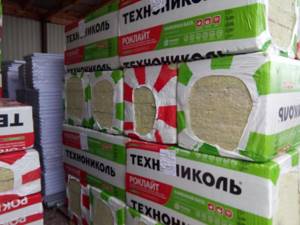
The material is produced in slabs, mats and rolls.
"Knauf"
An innovative and manufacturing German company whose construction products meet quality standards.
Popular brands of basalt-based wool:
- “Insulation DDP-K” – for insulating flat roofs;
- “Insulation FKL” – for insulating facades under plaster.
Also, the international Knauf group produces basalt material that provides reliable insulation of technical equipment, air conditioning systems and pipelines.
"Isover"
The French corporation Saint-Globen, which is a leader in the production of thermal insulation, produces high-quality stone wool under the Isover brand. The insulation products of this company have high technical characteristics and meet international standards.
Well-known brands of basalt thermal insulation material:
- “IsoverOL-E” – for insulating walls before finishing with plaster;
- “IsoverOL-TOP” – for arranging flat roofs.
The company also produces environmentally friendly stone wool for sound insulation of internal building structures and ventilated facades.
"Rockwool"
Danish manufacturer of thermal insulation materials made from natural stone. The company's products are known on the international market for their efficiency and environmental safety.
Widely used brands of basalt wool:
- “Rockmin”, “Domrock” - insulation for ceilings, frame partitions, floors on joists and roofs;
- “Panelrock” is a basalt material for insulating facades under siding and plaster.
Rockwool brand stone wool is popular for arranging interfloor ceilings and insulating roofs.
Basalt insulation is one of the best types of mineral wool. Using this material you can significantly save on heating your home and provide reliable soundproofing protection.
Distinctive characteristics
- Has a high degree of thermal insulation.
- Waterproof.
- Resistant to chemicals.
- Maximum exposure temperature – 1000 gr. WITH.
- Not susceptible to destruction by rodents.
- Does not respond to exposure to microorganisms.
- Long service life.
- Used as sound insulation for house walls and roofs.
- It has an average fiber thickness of up to 6 microns, length - 50 mm.
- High resistance to mechanical loads.
Widely used in the construction of residential and industrial buildings, catering establishments, for ventilation shafts, as thermal insulation, in the production of gas stoves, and refrigeration equipment. It does not compact over time, thereby maintaining its main functions - insulation of walls, for ceilings, insulation of parts.
Main categories
Wall insulation is divided into 2 groups:
- For internal insulation.
- For external insulation.
These categories differ from each other only in their ability to pass steam or retain it. Mineral wool, packaged in slabs, mats, rolls, is easy to use, easy to cut and fills the most inaccessible corners, leaving virtually no waste after cutting.
TechnoNIKOL
- Technofas. Available in the form of a slab measuring 600*1200*50/100 with a density of 145 kg per 1 m3.
- Technoven Standard. Plate. Dimensions 600*1200*50/100, density 80.
Knauf
- Insulation FKD. Slab (600*1200* 20-160, density 140 -150.
- Insulation FKL, plate. 200*1000*20-200, density 85.
- Insulation FKD-S, plate 600*1200*60-180, density 140-160.
- Insulation HTB, plate 1000*500*20-180, density 35-150.
Rockwool
- Fasrock, roll 1000*600*100, density 135.
- Wentirock max, roll 1000*600*50, density 50-90.
- Panelrock, plate 1000*600*50-100, density 65.
ATTENTION! The fine-fiber structure of mineral wool contains formaldehyde, and therefore is classified as a carcinogenic building material. For safe installation, it is necessary to have special protection for the worker performing insulation or insulation. To prevent fibers from scattering throughout the room, the pressed slabs should be protected with membranes. And only after that begin finishing work.
What to use for the roof?
As you know, the greatest heat loss occurs through the roof of a building, so special attention must be paid to insulating this zone (see How to properly insulate the roof of a house). A frivolous approach to selecting a heat insulator will force a stingy owner to pay twice. Basalt insulation for the roof must be at least 200 mm thick and securely fastened.
The insulating material “Basalt-Most”, which is used in the construction of children's and medical institutions, does not contain formaldehyde.
For pitched roofs use
- Insulation PAROS UNS 37, 610*1220*50, density 30 kg per 1m3.
- PAROS Extra 250*50, density 27-34.
- KNAUF 5500*1200*150.
- Rocklight 1000-1200*500-600*50-100.
- TECHNO slabs 100*60*5-10, density 126-154.
- Isover 1170*610*50 (see Isover: characteristics).
- Isovat 1000*600*50-100, density 30.
For flat roof
- PAROS Rob 50 1200 - 1800* 600, 900, 1200, density 20-30.
- Monrock Max 2000*1200*50-200, density 145 kg/m3.
- Technoruf N 1200*600*100, density 100-135.
The good ability to transform and the elasticity of the material guarantee a tight fit to any surface, leaving no air gaps between mats and slabs laid next to each other. When compressed, the volume decreases up to 6 times, which significantly increases loading capacity.
Dimensions
The consumer is interested in what form basalt insulation is produced in: its dimensions, dimensions and which one is better to choose. At the exit from the manufacturing plant, basalt wool is packaged in rolls. In warehouses it is cut to the required size and comes in 1 to 10 pieces per package.
On the packaging, the manufacturer indicates the sizes of mineral wool slabs in a certain sequence. The first is the length of the slab. This is followed by the width of the sheet and its thickness. The number of sheets is added to this information, which is important for the necessary calculation of the material.
Basalt wool price
The price of basalt wool depends on the degree of compaction and type. There is also a premium for brand awareness. Thus, Rockwool basalt wool costs about 2,000 rubles per cubic meter.
For products from little-known companies they charge about 25% less. The location of the company also plays a role. TechnoNIKOL basalt wool , for example, is domestic. You can save about 15%.
Foil cotton wool is more expensive than regular cotton wool. When it comes to forming material, cylinders are the most valued. For an aluminum-coated sample 21 centimeters long and 4 centimeters wide, you will pay, on average, 600 rubles.
For the same money you can buy 4 slabs measuring 120 by 60 by 10 centimeters. It also happens that cotton wool is 5 centimeters wide. It is taken for moderate climates and buildings that do not require extreme insulation.
average cost
Prices in Moscow for universal basalt heat insulator in slabs range from 1,500 to 3,500 rubles per 1 m3. A package with a volume of 0.3 m3 costs from 410 to 645 rubles.
In the regions, a basalt slab costs from 450 rubles per package of 0.288 m3 (sometimes you can buy it with a 20% discount), the product in rolls: 150 rubles per 1 kg. The price of material for rigid roofing work is approximately 1,680 rubles per 1 m3. The cost of environmentally friendly mats without phenol ranges from 1,300 rubles per 0.3 m3 package, with foil covering from 295 rubles per 1 m2.
Dimensions, weight, thermal conductivity, density
The technical characteristics of stone wool are superior to other insulation materials in many respects.
Basics:
1.Dimensions. There is no standard size for all types of stone wool.
The dimensions depend on where this type of insulation will be used. The length of the slabs ranges from 1000 to 1200 mm, width - 500-600 mm, thickness - 20-240 mm. 2. Density depends on the type of material. Indicators range from 30-40 kg/m3 to 190kg/m3.3. Water absorption - no more than 2% of the volume.
Hydrophobic material.4.Vapour permeability – 0.3 mg/(m.h.Pa).5.High fire resistance. Melting point: +1114C.6.Compressive strength at 10% deformation – 5-80KPa.
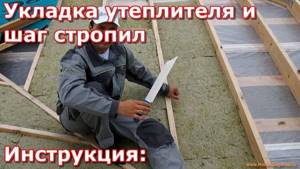
7. Thermal conductivity is low - 0.032¬ 0.048 W/(mK).
Standard sizes of basalt insulation
Basalt insulation is a thermal insulation material. Stone-based wool is popular among consumers because it has properties such as non-flammability and resistance to deformation. It has low thermal conductivity and hydrophobicity, and is readily used for insulation of residential and industrial premises. For ease of installation, basalt insulation is produced in slabs with standard sizes. Manufacturers can change the thickness, length and width of the product to satisfy all customer requests.

The advantages of basalt wool are: low thermal conductivity, long service life, resistance to the formation of fungus and mold, high sound insulation, fire safety and chemical resistance.
To work with walls, smaller sizes are usually used, which are convenient to install alone, and when insulating the roof, it is recommended to use longer and wider basalt slabs.
They can be coated on one side with various coating materials. Aluminum foil, fiberglass, or other materials are used as an additional covering. The edges of the sheets may have the ability to spring, which greatly facilitates the installation of insulation into a frame made of wood or metal. The flexible edge device is made on the long side and is marked with a special marking for user convenience. If the sides are difficult to distinguish, then marks must be left on the outside for ease of use.
Protection of wool on the facade
Mineral wool for the facade absorbs moisture well and “gives” it out very poorly, which is why the moisture stays inside and makes the insulation heavier. When the temperature rises and falls, the water inside the insulation freezes and melts. As a result, mineral wool for insulating facades may be destroyed. This process is called “zero crossing”, and very few hydrophilic facade insulation materials can withstand it without loss.
In order for façade wool to be less destroyed under the influence of moisture, water repellents are introduced into its composition, which prevent the accumulation of water in the wool.
To ensure that mineral wool for insulating facades lasts longer, membranes are also used in construction, the purpose of which is to protect the structure from moisture and wind.
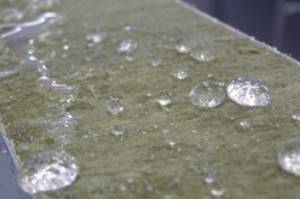
Wind and waterproof membranes are usually used outside, and vapor barrier films are used inside, the main task of which is to prevent steam from penetrating into the insulation from residential premises.
Vapor barrier also performs another important function - it protects internal living spaces from the penetration of microscopic fibers of basalt wool and glass wool.
A special feature of membranes is that they contain diffusion layers that are capable of conducting a pair in one direction. There are membranes that do not allow steam to pass through at all; these are simply “construction films.” They are made from several layers of polyethylene.
The membrane is very stable. If it is thin, it is very durable and has little stretch. It is important that the membranes are not affected by fungus and mold.
An important issue is the durability of the membrane. You should not buy membranes if their service life is limited to 10-15 years, because the material should last as long as the structure.
Under the influence of temperature, the membrane ages and its technical characteristics are significantly reduced. So, if the specification states that the material can withstand 80 degrees, then this is not at all enough, because in a poorly ventilated attic under a metal roof or between the roof and a residential insulated attic, the temperature rises much higher.
See more on this topic on our website:
- Technology of insulating facades with mineral wool A long time ago, in Soviet times, when houses were small and prices for gas and electricity were even lower, there was no question of energy saving. But today energy prices.
How to insulate a frame house with mineral wool In this material, Anton Fryashkin talks about insulating a frame house with mineral wool. Properly executed insulation of a frame house can significantly reduce the cost of heating the premises. Exactly.
How to insulate external brick walls with polystyrene foam Residents of a brick house, be it a high-rise building or a private house, are always concerned with the question of whether it is worth insulating their house from the outside. This is especially true for those regions where they are observed.
How can you insulate a wooden house from the inside and outside? It is believed that a house made of wood cannot allow cold to pass through, because the material from which it is made is a good heat insulator. But there are times when builders are not very conscientious.
How to insulate walls with expanded clay The issue of insulating floors and walls in residential buildings is always relevant, so you need to take the choice of insulation seriously. Expanded clay, as insulation for walls and floors of a house, corresponds.
One review on “What type of wool can be used to insulate the walls of a house? ”
There is one drawback to wind protection - it ages very quickly from ultraviolet radiation. It can only be in the sun for 1 month. It's falling apart.
Therefore, as soon as the walls are covered, immediately cover them with façade panels, siding, or hang planks.
Insulation of residential and industrial premises allows not only to create comfortable conditions for people to stay in them, but also to additionally protect wall/roofing material from temperature changes and, accordingly, the occurrence of condensation on its surfaces. The latter, as is known, leads to the formation of fungus and rotting of walls/ceiling/floors. Quite common today is insulation with basalt wool (including blow-in), which has proven itself to be the best technically and operationally. We will discuss below the technical characteristics of basalt wool insulation and how the material behaves during installation.
What sizes can basalt mineral wool have?
Scheme of ceiling insulation with mineral wool.
Manufacturers offer slabs made of basalt insulation of different types and parameters. They can be lightweight, intended for use as sound insulation and thermal insulation:
- internal walls;
- floors;
- attic insulation;
- insulation of roof structures.
The slabs used most often have dimensions of 1000 x 600 x 50 mm. The package contains at least 10 pieces, and the covered area with this quantity will be 6 m². Products are packaged in polyethylene film.
These types of sheets with mineral wool can be installed during facade work without installing windproof films. They are readily used with frames with a hinged structure.
The industry produces rigid boards made with a synthetic binder material. Their dimensions are 1000 x 600, and their thickness can vary from 30 to 200 mm. Different sizes allow consumers to select the desired type and carry out installation work in one layer. This brings great savings in time, effort and materials for installation.
The peculiarity of basalt slabs is that they have a combined two- or three-layer structure. Their outer layer is denser, and the lower inner layer is particularly light. The hard layer is specially marked so that it is placed on the outside. Thanks to this, products with large parameters are easy to use and do not require the involvement of many workers.
Scheme of thermal insulation of a wall with basalt insulation.
When installing facade insulation, the products are suitable for plastering walls over a steel reinforcing mesh or over the surface of the outer layer.
For further plastering with a thin layer that will fall on the insulation, use façade types that have a special top coating. It is specially created to ensure that the plaster adheres to the surface.
Parameters of this type are 1000-1200 long, 500-600 wide and 50-180 mm thick. The use of basalt as thermal insulation on the outside of buildings allows for surface finishing by applying a thin layer of plaster.
For facade work, special lamella strips of standard sizes are offered to insulate walls with a curved surface.
